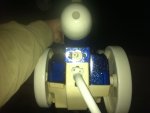I'm having a problem with my Polaris 280.
It seems to be too buoyant. When in operation, it tends to leave the bottom of the pool and swim around in the 'air'. When not in operation, it sits with the rear end off the bottom of the pool. If I take it out and throw it back in the pool, it sinks very slowly.
The result is that it does not do a good job of cleaning the bottom, and almost every day manages to tie itself in a knot around the hose connection at the side of the pool.
Now what this is not:
* Air trapped in the unit. All air is out of the unit.
* Air in the line. I can see it, there's no air going through the line.
* Incorrect settings on the various adjustments and spouts. I've played around with the float, tail pressure, position of the rear propulsion control to no avail. In any case, the problem is evident when the unit is OFF.
* Position of the hose floats. I've played around with this, and there no tension on the floats when the unit is on the bottom of the pool. I can hold the hose under the water while the unit is on the bottom, and it still doesn't have all wheels on the 'ground'.
* The backup device. This is operating normally - no water flow when it's supposed to be between backup cycles.
I've tried adding weights (took it apart and put them inside, hung weights on various appendages, etc.) but mostly this seems to throw the unit out of balance so it will either fall on its side or otherwise malfunction - it does stay on the bottom though.
My last guess is the following: I have a salt water chlorinator, so there's a lot of salt in the water. I think that would make the unit more buoyant. But if so, I would expect to see some chatter on the internet from others with similar problems.
Maybe I'm missing a part, though this is hard to imagine?
Any ideas would be appreciated!
Thanks,
Jerry
It seems to be too buoyant. When in operation, it tends to leave the bottom of the pool and swim around in the 'air'. When not in operation, it sits with the rear end off the bottom of the pool. If I take it out and throw it back in the pool, it sinks very slowly.
The result is that it does not do a good job of cleaning the bottom, and almost every day manages to tie itself in a knot around the hose connection at the side of the pool.
Now what this is not:
* Air trapped in the unit. All air is out of the unit.
* Air in the line. I can see it, there's no air going through the line.
* Incorrect settings on the various adjustments and spouts. I've played around with the float, tail pressure, position of the rear propulsion control to no avail. In any case, the problem is evident when the unit is OFF.
* Position of the hose floats. I've played around with this, and there no tension on the floats when the unit is on the bottom of the pool. I can hold the hose under the water while the unit is on the bottom, and it still doesn't have all wheels on the 'ground'.
* The backup device. This is operating normally - no water flow when it's supposed to be between backup cycles.
I've tried adding weights (took it apart and put them inside, hung weights on various appendages, etc.) but mostly this seems to throw the unit out of balance so it will either fall on its side or otherwise malfunction - it does stay on the bottom though.
My last guess is the following: I have a salt water chlorinator, so there's a lot of salt in the water. I think that would make the unit more buoyant. But if so, I would expect to see some chatter on the internet from others with similar problems.
Maybe I'm missing a part, though this is hard to imagine?
Any ideas would be appreciated!
Thanks,
Jerry


